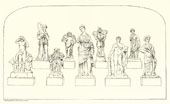Previous First Next
SALAMIS IN THE ISLAND OF CYPRUS.
BY ALEXANDER PALMA DI CESNOLÀ, F.S.A.,
page 99
in the other hand is a ball; on his head is an ample hood, or cap, turning over at the top, and furnished with large lappels, which fall on his shoulders; it is, in fact, the famous Phrygian cap, like that with which Paris is represented. Bound his neck is a thong like necklace, with a pendant which strongly resembles a cross. There is a chubby figure, which, like the last, is naked, except for the cap he wears. This garment is, however, unlike the last-named example. It is formed into a high cone, like an old-fashioned English nightcap. This peculiar cap pertained to the inferior orders of the people. There is adraped figure of a boy, standing erect in a tunic, and wearing on his neck a collar, like that just now mentioned. He is crowned with a wreath. In one hand, he carries what seems to he a small bag or sack, while, with the other hand, he caresses, a little dog with long hair and a bushy tail, exactly such a creature as that which is called a Siberian dog. Another boy has fallen back on the ground, and is assailed by a playful dog of the same kind. This figure is draped. The figures of babes are squatted on frusta of columns, or cylindrical pedestals, the fronts of which are channelled with undulating fluengs. There is a very pretty figure of a boy of about ten years of age, whose costume comprises boots, with pendant lappels at each side, and laced up the front. He is wrapped in a large and long mantle, fastened at the shoulder by a fibula, and enclosing both his arms and hands. Jauntily placed on one side of his head is a flat woven cap, exactly like that which the Spaniards call a birréta, and by the red, blue, or white colour of which the wearer indicates his political leanings. Doubtless, this figure represents an urchin going to school. The same cap occurs with other statuettes. What is nearly as much like a girl as a boy, stands and holds a dove on one arm. There is a fully-draped figure of a winged boy-genius seated on the ground, ' with its wings fluttering at its shoulders, and with a duck against its knee. On the head is a' flat cap, rising to the back and front of the head, exactly like a cap which English ladies wore not many years ago. À winged boy-genius stands naked, holding a shield, which bears illegible blazonry, and wearing on his head a crested helmet, shaped in the fashion appropriated to Pallas, and leaning on a staff, the head of which seems to terminate in that which closely resembles a fir-cone. A half-clad boy-genius, whose body is bare, stands in a graceful and animated attitude, with his wings expanding from his shoulders. He is crowned with a large garland. He is leaning against a pedestal, with one foot in advance of the other. The execution of this charming statuette is so light and free, that it reminds me of works of the early renaissance sculptors even more than of that Greek art, of which, nevertheless, it is an unchallengeably delicate illustration. We next approach a group of six statuettes, found by me in a single ruined building at Salamis, four of which are, doubtless, the work of one artist, a suggestion confirmed by the likeness of each figure to its fellows, in treatment, handling, and even in the faces. This is, therefore, a peculiarly interesting class of relics. The most attractive is a very energetic group of two little boys at play. The actions of the hands suggest very strongly indeed that we have here a representation of the extremely ancient game of Morra, which was played by throwing out the thumb, or  one or more fingers of one hand, in order that the player's antagonist might guess the number of digits thus thrown forth. A fine large bronze figure of a boy in the act of playing the game is in the select case of the Bronze Room in the British Museum, to which Mr. Newton has drawn my attention. This game is still in vogue. The figure on our right is remarkable on account of its cap, which is of the flat, felted kind, like that worn by statues of Mercury, being detached from and independent of the head. The second figure is that of a winged boy-genius, Somnus, or Hypnos, lying on his left side, with one arm and one wing under his head, his knees bent up, and one or more fingers of one hand, in order that the player's antagonist might guess the number of digits thus thrown forth. A fine large bronze figure of a boy in the act of playing the game is in the select case of the Bronze Room in the British Museum, to which Mr. Newton has drawn my attention. This game is still in vogue. The figure on our right is remarkable on account of its cap, which is of the flat, felted kind, like that worn by statues of Mercury, being detached from and independent of the head. The second figure is that of a winged boy-genius, Somnus, or Hypnos, lying on his left side, with one arm and one wing under his head, his knees bent up, and
Previous First Next
|